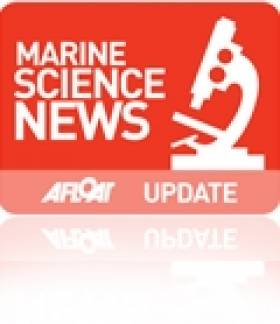Displaying items by tag: CO2
#fish – Deep sea fish remove and store more than one million tonnes of CO2 from UK and Irish surface waters every year, according to a new study completed by researchers from the Marine Institute and the University of Southampton, UK.
It has been commonly thought that the ecosystem of deep water fish such as orange roughy, grenadiers and smoothheads depend on particles that fall from the surface waters for their food source. These bottom living deep water fishes never come to the surface and the carbon in their bodies therefore stays at the seafloor.
The team of researchers from the University of Southampton and the Marine Institute collected samples of fish on the continental slope west of Ireland, at water depths ranging from 500 to 1800m, during the deepwater research surveys on the Marine Institute's research vessel RV Celtic Explorer.
Using novel biochemical tracers to piece together the diets of deep-water fish revealed their role in transferring carbon to the ocean depths. "It was previously thought that these deepwater fish depended on "marine snow", organic particles falling from the surface, for their energy. We now however know that a huge volume of animals make daily vertical migrations from the mid-slope depths to feed at the surface during the night. The animals conducting this migration, then transport nutrients from the surface back to the deep," explained Graham Johnston, Marine Institute.
The researchers measured forms, or isotopes, of carbon and nitrogen, in the muscles of fish caught. Small differences found in the mass of these isotopes mean that they are processed at slightly different speeds in the body of the fish, leading to patterns which can show who eats who in the slope ecosystem. By measuring the isotopes in all of the most common species, the researchers were able to estimate how much carbon is captured and stored by these deep water fish. The marine scientists found that more than half of all the fishes living on the seafloor get their energy from animals that otherwise go back to the surface, and not from settling particles, as originally thought.
These bottom-living fishes therefore become a carbon capture and storage facility. Global peaks in abundance and biomass of animals at mid slope depths occur because this is the depth range where the vertically migrating animals are most easily captured by fishes that live at or near the seafloor.
Fish living in deep waters on the continental slope therefore play an important role carrying carbon from the surface to the seafloor. "This natural carbon capture and storage scheme could store carbon equivalent to £10 million per year in carbon credits," said lead author, Dr Clive Trueman from the University of Southampton.
"As fishing, energy extraction and mining extend into deeper waters, these unfamiliar and seldom seen fish in fact provide a valuable service to all of us. Recognising and valuing these ecosystems is important when decisions are made in relation to exploiting deep water habitats for food, energy or other mineral resources."
Dr Peter Heffernan, CEO of the Marine Institute congratulated the teams involved in this research highlighting the importance of such collaborations of research in Irish and UK waters. "Through this research, both the University of Southamption and the Marine Institute continue to promote the sustainable development of our oceans resource, while maintaining a healthy ecosystem".
The study, Trophic interactions of fish communities at midwater depths enhance long-term carbon storage and benthic production on continental slopes, by C. N. Trueman, G. Johnston, B. O'Hea, and K. M. MacKenzie (2014) is published in the journal Proceedings of the Royal Society B, and was funded by the University of Southampton and the Marine Institute.





























































